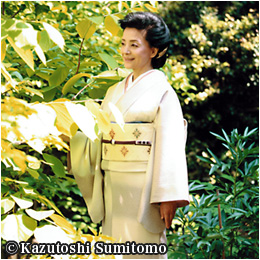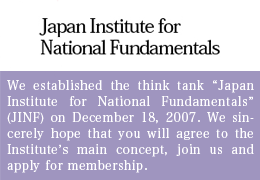Prime Minister Abe Must Pursue Independent Diplomacy with the US
Shinzo Abe, Japan’s new prime minister visiting Washington on Februray 21 for the first time since assuming the premiership last December, has a tough assignment cut out for himself as he seeks to cement Tokyo’s relationship with Washington.
His quick decision-making as prime minister having thus far made quite a favorable impression, Abe’s approval rating has steadily been climbing in all of the newspaper polls. However, it is worth noting that his popularity appears to primarily reflect the public’s approval of his domestic policies.
Abe faces a number of tough diplomatic, international trade, and defense issues. Although US-Japan relations constitute the most important alliance for Japan, a number of crucial matters that should have been worked in recent years – such as the move of the Futenma US Marine Corps Air Station in Okinawa, the decision on exercising the right to collective self-defense, and participation in negotiations on the Trans-Pacific Partnership (TPP) – remain unresolved.
In order to maintain the momentum of his first few weeks in office, Abe must in his discussions with President Obama bring a commitment to joining the Hague Convention on child-custody and abduction as well as at least start to pave the way for Japan’s participation in the TPP free trade negotiations. Unless Abe succeeds in resolutely forging independent foreign and security policies, Japan will likely be swiftly lost in the broader shuffle of US-Europe and US-China relations.
At least part of the difficulty the Abe administration faces in cementing its ties with Washington derives from two factors: (1) the character of the second-term Obama administration is notably different from the first; and (2) virtually all of the members of Obama’s inner circle are left-leaning centrists who tend to see the US relationship with China as carrying more weight than that with Japan.
I would consider it reasonable – as well as inevitable – to expect the second Obama administration to drastically reduce US military spending to cope with a persistent budget deficit, effectively backing off of its commitment to safeguarding the peace and security of the Asia-Pacific region. The US administration will likely become more inward-looking, as it inevitably will be compelled to pour more resources into tackling domestic problems.
With the US trapped in such a state of affairs, Japan should in no way exhibit any desire to continue to indefinitely depend on the US in terms of its own security. As leader of a vital Pacific ally of the US, Mr. Abe must confidently show his mettle to pursue a friendly yet firmly independent policy towards the US. He must demonstrate a resolve to overcome some of Japan’s serious weaknesses hampering its relations with the US, determined particularly to not allow the post-war security arrangement – under which Japan’s national security depends wholesale on the US – to continue interminably,
On top of that, Abe must maintain amicable relations with the left-leaning centrist US administration, fully aware of its propensity to favor China over Japan.
“League of Democracies”
In the first year of his first administration, President Obama sought to adopt a “G-2” world view with every intention of pursuing a global strategy revolving around a pillar made up of the world’s two biggest economic and military powers – the US and China. We should not forget that Japan’s national interests were completely ignored by Washington at the time.
It was former Secretary of State Hillary Clinton who managed to change the G-2 concept. Seeing through China’s ambition and menace, Clinton managed to fundamentally change over-all US foreign policy by introducing a new element – that of placing more emphasis on the importance of Japan – although there was little she could do to fundamentally change the great importance attached to China. In point of fact, Mrs. Clinton kept China in check on January 18 this year when she demonstrated a deeper US commitment to Japan’s security vis-à-vis the disputed Senkaku Islands by telling visiting Japanese Foreign Minister Fumio Kishida: “We oppose any unilateral actions that would seek to undermine Japanese administration (of the islands). ” But now Mrs. Clinton has left office, being replaced by John Kerry.
From the Japanese perspective, even Clinton was apparently learning towards China in her first year as secretary of state. Even so, she chose Japan as her first stopover during her first visit to the Asia-Pacific, although her stay in Japan was only 22 hours. As for Mr. Kerry, he appears to have little interest in Japan.
It has already been pointed out that Kerry failed to refer to Japan even once during his confirmation hearings before the Senate Foreign Relations Committee on January 24. This despite the fact that Japan is a vital ally of the US; that it is still the world’s third largest economy; and that betterment of US-Japan strategic relations has an important bearing on each other’s national interests.
Instead, Kerry devoted much time to discussing China, basically emphasizing the following points: (1) the US should not regard China as an enemy; (2) relations with China, a major power of the world, must be strengthened; (3) rules must be established with China vis-à-vis critical issues like intellectual property rights; and (4) a system of collaboration can be set up regarding various vital issues, if the US and China can reach an agreement on certain basic conditions.
So, a new G-2 – a return to what the first Obama administration visualized – is in the offing. Clearly, this second Obama administration is hammering out a new Asian policy quite different from that envisioned by Mrs. Clinton. Prime Minister Abe – and the entire Japanese nation for that matter – must be prepared to face up to this reality.
Beyond comparing Kerry to his predecessor, Secretary Clinton, I somehow cannot help but compare him to Senator John McCain of the Republican Party. During the 2008 presidential election campaign, McCain said he would, if elected president, form a “League of Democracies” in place of the United Nations.” He was defeated by Mr. Obama, but I still think how wonderful it would be if a League of Democracies were to materialize.
After all, the United Nations can be seen as just a league of nations that won World War II. As a matter of fact, the UN charter still contains the “enemy state” clause, with permanent members of the Security Council wielding their vetoes in order to safeguard their national interests.
The proposed “League of Democracies” would readily impose the necessary sanctions on North Korea, which has aggressively threatened its neighbors and brazenly abducted scores of Japanese citizens. Furthermore, it would not allow China such a prerogative as a veto when it has no scruples whatsoever about having massacred Tibetans, Uyghurs, and Mongolians over the years. I would consider McCain’s foreign policy, which emphasizes a sharing of fundamental human values, far more wholesome and desirable than Kerry’s, which advocates diplomacy favoring an exclusive G-2 relationship with China.
Comparing Kerry and McCain further, if I may, one notices an interesting similarity: they are both Vietnam War heros, although of a dramatically different nature.
Compatibility of Values
McCain was shot down while on a bombing mission over North Vietnam in October 1967, suffering broken bones in both hands and both legs, and then taken captive. He was severely beaten at times, while being confined to a solitary cell during much of his captivity of five and a half years until his release in March of 1973.
Kerry also fought in Vietnam in 1968, and was decorated for his heroism while serving there. However, upon his discharge in 1970 he became heavily involved in anti-war activities. In April of 1971, he delivered an anti-war statement during a Senate Foreign Affairs Committee hearing as a member of the US Navy Reserve. The following day, along with hundreds of other Vietnam War veterans, Kerry threw his medals, as well as some entrusted with him by other veterans who could not make their way to Washington on that day, as “trash” over a fence erected on the steps of the US Capitol building as a protest against the war. Footage of this behavior by Kerry is said to have been shown as a tool of mental torture to McCain and other Americans still in captivity in North Vietnam at the time. (John F. Kerry by Michio Ochi; Takarajima-sha, Tokyo; 2004)
I once visited the camp in what used to be North Vietnam where McCain and his buddies were once detained. I still recall the eerie smallness of the solitary cells, the metal fittings and iron chains that locked the prisoners’ feet, and the cells’ thick mud walls with no windows. When McCain finally reached home after five and a half years of life in prison, he was not discharged, instead continuing to serve in the US Navy as an officer for some time thereafter.
It’s not my intent to make arguments here simply for argument’s sake. But in all honesty, I wish to state that the way in which McCain has lived his life does indeed strike a sympathetic chord in me. That may be because I suspect that my values are more compatible with McCain’s.
At a time when China’s growing military and economic might is steadily becoming more menacing to Japan and China’s other neighbors, it is mandatory to forge relations between Tokyo and Washington that are satisfactory in all respects. However, there definitely is a gap between our two nations in the same way that there is between any two nations. It is a gap between values that can and cannot be shared. Typically, the latter pertains to a perception of war-time history.
I feel that compatibility in terms of basic human values is of the utmost importance for leaders as both the US and Japan now strive to develop mutually satisfactory relations by swallowing differences of opinion on difficult issues. Will the current Japanese administration be able to develop such a compatibility with Kerry? I will continue to follow the development of Abe’s foreign policy with the utmost interest on this and other issues.
(Translated from “Renaissance Japan” column no. 547 in the February 28, 2013 issue of The Weekly Shincho)








